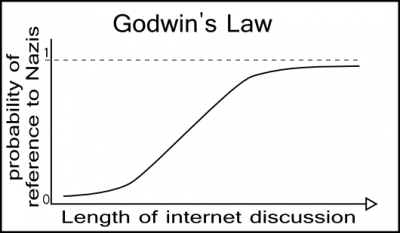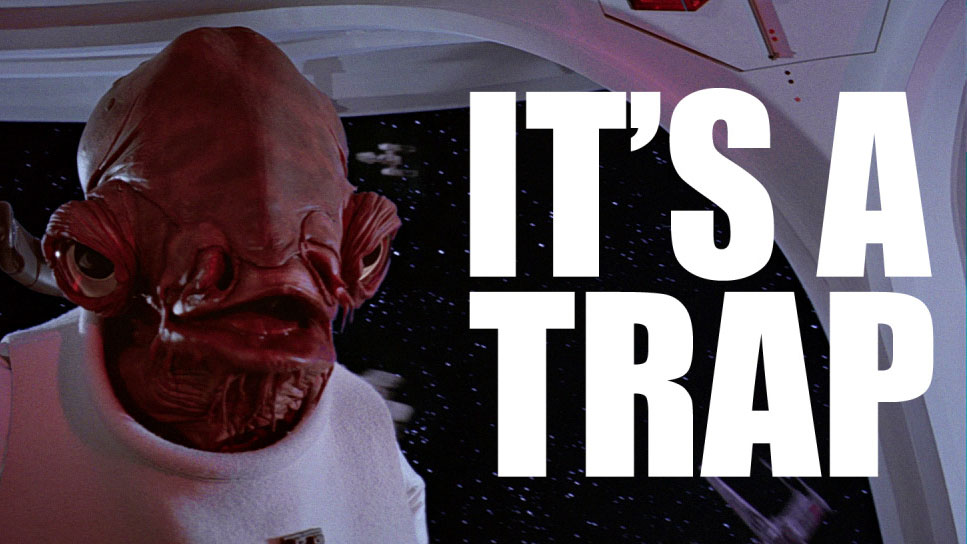May 9, 2019
The Evolution of Meme Culture

By: burgundy bug
The egg who has more likes on Instagram than Kylie Jenner
Source: Let’s set a world record together… | world_record_egg
Memes are the currency of the world wide web. Love them or hate them, they’ve fostered global connections and raised an entire generation.
A Bit of Context…
The term “meme” is relatively new. The word was coined by the British scientist Richard Dawkins in his book The Selfish Gene, published in 1976, according to Merriam-Webster’s Dictionary.
Defined by Dawkins as “a unit of cultural transmission,” memes serve as a sort of inside joke to the children of the digital age; millennials.
However, this concept is nothing new.
Killroy, the World War II “meme”
Source: The World War II meme that circled the world | Vox
Soldiers drew a cartoon figure peering over a ledge with a large nose accompanied by the words “KILLROY WAS HERE” all over the world during World War II (WWII), according to Phil Edwards’ video “The World War II meme that circled the world” on Vox.
“He was a joke, but also kind of assurance. A hero who had been there and still made it out okay.”
Phil Edwards
Although the origins of the figure remain a mystery, the name Killroy may refer to the shipyard inspector James J. Killroy who wrote “Killroy was here” on everything he inspected.
“Soldiers saw it and then turned into a joke,” Edwards says.
The Evolution of Meme Culture
The First Memes
As dial-up internet weaseled its way into households across the globe, we found ourselves more connected than ever.
AOL Instant Messenger logo
Source: AOL Instant Messenger logo, 1999.png by Mazdapickup89 | Wikipedia
The dawn of instant messaging services such as AOL Instant Messenger, Microsoft Network (MSN), and Yahoo Messenger, prompted internet-savy users to quickly adapt shorthands such as “LOL” (laugh out loud), “BRB” (be right back), and “TTYL” (talk to you later).
Some users wow’d their friends list by adorning their profiles with “ASCII Art,” including the infamous “ROFLCopter.”
Incoming ROFLCOPTER!
ROFL:ROFL:ROFL:ROFL
___^___ _
L __/ [] \
LOL===__ \
L \___ ___ ___]
I I
----------/ROFLCopter
Source: ROFLCOPTER ASCII Text | bhilburn
Godwin’s Law
Source: Godwin’s Law | Know Your Meme
Godwin’s Law was among one of the first memes to circulate the internet, Oldest reports.
This law originated on Usenet forums from Mike Godwin, who had observed the longer a discussion went on the odds of Nazis or Hitler being mentioned increased, according to Usenet legend Tim Skirvin.
“As a Usenet discussion grows longer, the probability of a comparison involving Nazis or Hitler approaches one.”
Mike Godwin
Dancing Baby Cha-Cha
Source: A Brief History of the Dancing Baby Meme | Tech Crunch
The “Dancing Baby” or “Baby Cha-Cha” gif imposed on top of the intro to the music video “Hooked on a Feeling” by Blue Sweede spread like wildfire across email chains in 1996, Oldest says.
“IT’S A TRAP” – Admiral Ackbar
Source: It’s a Trap | Know Your Meme
A few years later, “IT’S A TRAP” pathed the way for the landscape of reaction memes as we know it today.
The words are a quote from Admiral Ackbar in the film Star Wars Episode VI: Return of the Jedi. They are pasted over an image of Ackbar in all white text.
“SHUT UP AND TAKE MY MONEY” – Fry
Source: shut up and take my money by liliana_von_k | Flickr
It wasn’t long before similar reaction images, such as Fry from Futurama’s “SHUT UP AND TAKE MY MONEY,” and captioned images of Chuck Norris, became all the rage.
… Speaking of rage, black and white faces drawn to convey a wide variety of expressions known as “Rage Comics” quickly invaded forum boards in the mid-2000s and lingered around long enough to plaster themselves across the walls of Facebook users.
Dimensions of Rage
Source: Reaction Images | Know Your Meme
Some of the most recognizable faces of Rage Comics include the Troll Face, Rage Guy (FUUUU-), and Me Gusta.
Troll Face, Rage Guy, and Me Gusta
Source: Know Your Meme
These characters inspired art, jokes, videos, and still have an impact on meme culture today. While they’re not as prevalent as they once were, they remain a nostalgic token of the internet’s more recent past.
Rage Comics in “real life”
Source: Rage Comics – In Real Life | PistolShrimps
Before we get too far ahead of ourselves, let’s take a moment to backtrack to the beginning of YouTube.
The Beginning of YouTube
Long ago, in an digital world before YouTube was a platform for major media networks and the birthplace of internet celebrities, it was a hub of the hottest “viral” videos.
Of course, “going viral” now is far different from what it once meant.
In ye olden days, “going viral” meant being a one-hit wonder with a few hundred thousand views on a video or two. Now, “going viral” lands you on national television, perhaps with a book or record deal, all while accruing a few million followers.
Burgundy Bug
YouTube was created by Chad Hurley, Steve Chen, and Jawed Karim in 2004, as reported in an article published by USA Today in 2008.
Jawed Karim at the Zoo
Source: Me at the zoo | jawed
The first video was published by Karim on Apr 23, 2005.
It wouldn’t be long before the platform would find itself home to the first viral videos, including: “Evolution of Dance,” “FRED,” “Numa Numa,” “Shoes the Full Version,” “Charlie bit my finger – again !,” “Charlie the Unicorn,” “Foar Everywun Frum Boxxy,” and Dane Boe’s “Annoying Orange,” to name a few.
Other viral sensations included Tay Zonday’s “Chocolate Rain,” Smosh’s music video to the Pokemon theme song, and “The Stormtrooper Air Hump.”
A variety of trends also took off during this time period, such as “TRY NOT TO LAUGH” challenge videos and the infamous art of “Rick Rolling.”
Never Gonna Give You Up by Rick Astley
Source: Rick Astley – Never Gonna Give You Up (Video) | Official Rick Astley
Rick Rolling
For those of you who aren’t familiar, “rick rolling” is when you trick someone into clicking a link – generally one that has been disguised using websites such as TinyUrl – only for them to end up on the music video for Rick Astley’s 1987 single “Never Gonna Give You Up.”
The original “rick roll” video was removed from YouTube in 2010 for violating terms of service, causing an uproar. Within one day, YouTube reuploaded the video claiming it had been taken down by “mistake,” according to an article published by Neowin.
Unfortunately, it seems the biggest joke in the rick roll phenomenon was played on no other than Astley himself. Despite the video totaling over 558 million views as of May 2019, the singer only received $12 in royalties as of 2010, The Register reported. Astley did not compose the song, so he is only entitled to his share as the performer.
Memes 2010 – Present Day
How memes have changed
Source: How Memes Have Changed | CircleToonsHD
This last decade has been a rollercoaster for meme culture. We witnessed the rise and fall of Vine, tuned in to Smash Mouth’s “All Star” in lieu of “Never Gonna Give You Up,” and watched as Baby Cha-Cha was replaced by a dancing alien who’s moves were just as smooth.
Dancing Alien gif
Source: When U Mom Com Home And Make Hte Spagheti | Know Your Meme
The amount of people who use the internet has also increased over the last 10 years.
28.7% of the global population was online in June 2010. 56.1% of the global population was online as of March 2019.
Internet World Stats
Subsequently, the amount of users on Twitter, Facebook, and Instagram have skyrocketed. Statista estimates there will be 2.77 billion active profiles on social media by the end of 2019.
Platforms such as Tumblr and Reddit also exploded throughout this era, birthing their own meme subcultures.
Fandoms – groups of individuals who are “fans” of a particular artist, tv series, and so on – further connected the internet. Fans on Tumblr, Reddit, and Twitter alike would live-post their reactions to the latest content of whatever they were following and share a laugh over memes “only real fans” would get.
As far as YouTube goes, the vloggers we grew up alongside either faded out or made their on-screen debut in films or short-lived TV series, such as “FRED: The Show.”
Trends and challenges have come and gone. Around the globe, people choked down spices for the cinnamon challenge, stuffed their cheeks for the chubby bunny challenge, tested their luck with the Beanboozled challenge, and soaked themselves for the chilling ALS Ice Bucket Challenge.
Prank videos also gained a bit of traction in the mid 2010s. However, their popularity quickly faded as popular prank YouTubers were exposed left and right for editing or staging their videos.
Memes today may look a bit different from the trollfaces and annoying oranges we once bedazzled all over our pages and profiles, but nevertheless, the concept remains the same at its core.
As Dawkins had put it, memes are a “unit of cultural transmission.” Just as Killroy connected soldiers across the globe, we have found ourselves united by the likes of Norris, Astley, Zonday, and Me Gusta.
It’s hard to say where memes might be in the next decade. One thing’s for sure though:
Memes are here to stay.
Interested in having content featured in an upcoming blog post or issue of The Burgundy Zine? Head on over to the submissions page!
For all other inquiries, please fulfill a contact form.
This entry was posted in Blog, Culture, Blog, Entertainment, Blog, History, Hot Stuff, 2019, Spring 2019, May 2019 and tagged in annoying orange, burgundy zine, burgundyzine, burgundyzine.com, comedy, facebook, facts, forums, fred, funny, google, history, humor, instagram, interesting, internet, internet culture, jokes, journalism, leroy, leroy was here, may 2019, me gusta, meme, meme culture, meme history, memes, pop culture, rage comics, rick astley, rick roll, rickroll, roflcopter, social media, the burgundy zine, The Evolution of Meme Culture, troll face, twitter, vox, world war ii, wwii, youtube, youtubers.

burgundy bug
https://burgundyzine.com/about/#burgundybugA cynical optimist and mad scientist undercover, burgundy bug is the editor, graphic designer, webmaster, social media manager, and primary photographer for The Burgundy Zine. Entangled in a web of curiosity, burgundy bug’s work embodies a wide variety of topics including: neuroscience, psychology, ecology, biology, cannabis, reviews, fashion, entertainment, and politics. You can learn more about working with burgundy bug by visiting her portfolio website: burgundybug.com
View more posts from this author









